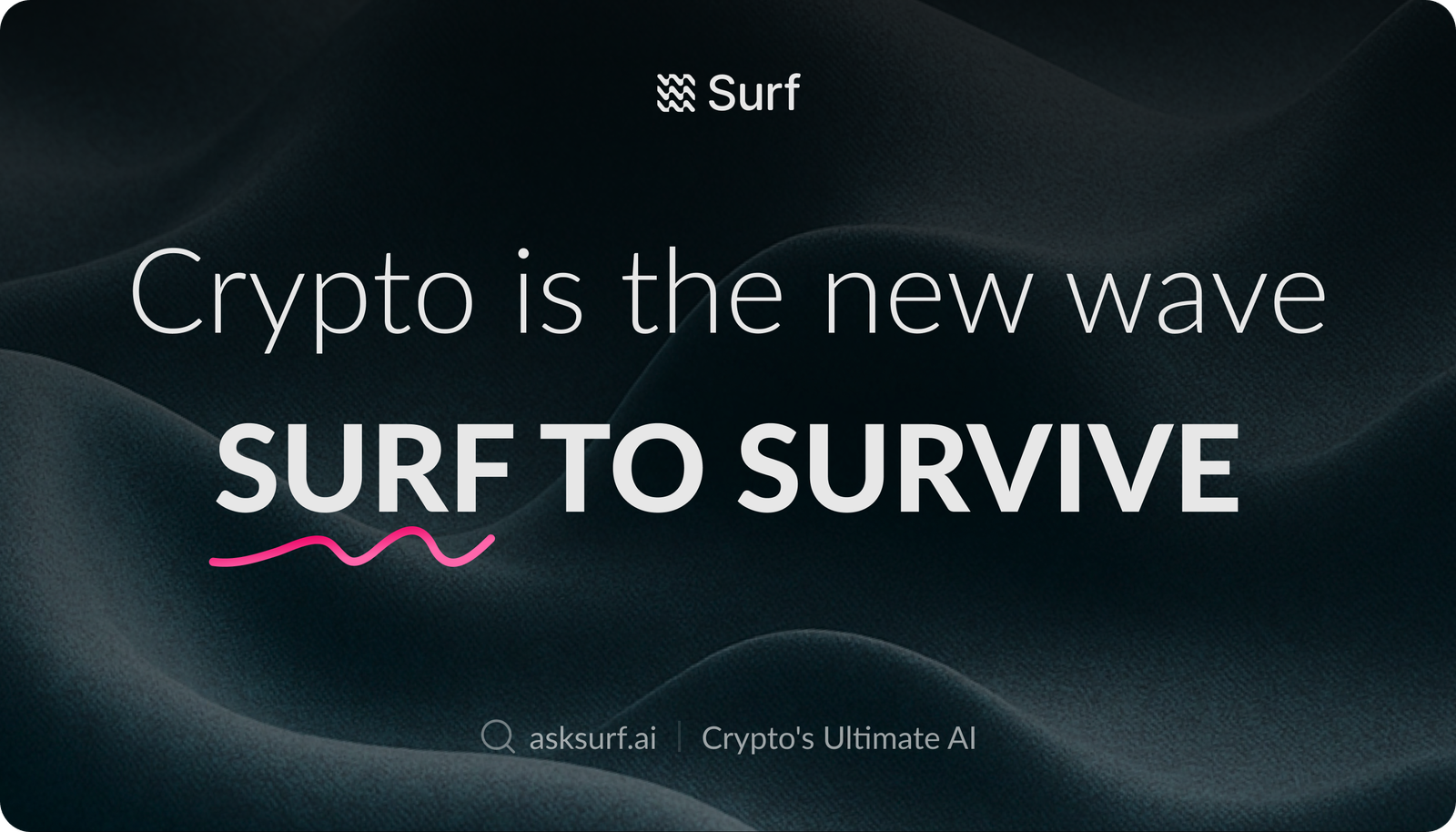Where the World Settles Up gm Bankless Nation,
Crypto isn’t just speed-running finance’s past – it’s rewriting it with math instead of lawyers. Today's article from David Hoffman dives into the world of transaction settlement and authorization, and what the future relationship among DeFi, Ethereum L2s and the L1 might look like. Scroll down to see our rundown of links to updates across Ethereum and the latest Rollup episode. Thanks for being a subscriber,
luma 🫡 Sponsor: Surf — AI-powered crypto copilot that combines institution-grade research and onchain execution. . . . OPINION Ethereum L1 Is Where the World Settles Up Crypto is speed-running the history of Money and Finance. This is a trope we’ve used at Bankless ad infinitum. It’s a solid model to illustrate why things have previously felt primitive, while simultaneously being full of potential. - First, we created internet native commodity-monies to mirror gold, silver, and other hard metals ➡️ BTC and ETH.
- Then, we created synthetic deposit-backed IOUs that mirrored early renaissance bank notes ➡️ MakerDAO’s DAI, Bitshares' bitUSD, Liquity’s LUSD, Frax’s frxUSD, more recently Aave’s GHO.
- DeFi produced early marketplaces and credit institutions ➡️ Uniswap, Aave, Fluid, dYdX, and more recently Hyperliquid.
We have recreated many of the basic building blocks of a robust financial system, except this time all the components are built on cryptographic proofs and crypto-economic assurances, rather than being backed by courts, legal systems, and ultimately a monopoly on violence. In the TradFi world, there is no true notion of “settlement finality.” In TradFi, there is no transaction that cannot be undone. “Finality” in the TradFi sense, is produced by legal assurances. The story goes that, if you do things legally, the courts will uphold and protect the legitimacy of your transaction. But courts themselves are squishy and subjective. Competent and well-paid lawyers can take advantage of this fact. Laws can change! Humans are messy, and everything downstream of humans tends to embody our messiness. As a result, no transaction settled in TradFi is safe. Everything can be undone – given the right amount of pressure in the right spot. The TradFi financial system is built around this truth, but the DeFi ecosystem has this property completely stripped from its foundations. In DeFi, cryptography has replaced law; which is where we get the “Code is Law” notion. - Laws are not permanent. They are subjective, squishy, and subject to change.
- Math is forever. It is objective, hard, and infinite.
A financial system based on Math is fundamentally more scalable and trustworthy than a financial system based on one specific country's legal system, no matter how trustworthy and reputable that legal system is. How L2s Fit in Math-Based FinanceAll of this setup is meant to deliver a punchline about how L2s fit into this model of “crypto speed-running the history of money and finance… but with math instead of law” But, before I attempt to land that punchline… more context! People tend to think Visa is a “payments network.” Visa is not a payments network. Visa doesn’t touch money. No money changes hands when you swipe your Visa credit card. Visa is an authorization network. When a customer swipes their credit card, the merchant’s Point-of-Sale terminal collects your card data and transaction details, encrypts it, and sends it to the merchant's bank. The merchant's bank then takes this information and packages it through VisaNet, Visa’s communication network. Visa routes this information to the customer’s bank, and the bank queries: Is this card valid? Does the card have sufficient credit? Does the transaction pass our fraud rules? After these queries, the customer's bank issues an Approve or Decline response, which goes back through VisaNet, to the merchant's bank, and finally back to the PoS terminal at the merchant. All of this happens in 1-3 seconds. No money has moved. Next, every merchant and every customer on the Visa system batches their daily transactions together. They send their batches to their bank, which sends them back to Visa. Visa aggregates all batches from all banks, and nets them out. Once netting is done, Visa instructs actual money transfers. This happens on settlement networks like Fedwire, ACH, or local equivalents. Money is moved on Fedwire, or other lower-level settlement layers. Visa’s strength comes from its assurances that approved transactions are actually approved, and are unlikely to be disputed later in courts. That’s a main value proposition of Visa’s product. In order to achieve this, Visa has layers and layers of checks and rules for optimizing the Approval or Decline process, so that the much more expensive court system never has to be invoked. There are many authorization networks like Visa (Mastercard, Amex, Discover, Paypal, Venmo, Zelle, Alipay, WeChat Pay, Apple and Google Pay), and all of these follow the same pattern of passing and aggregating authorizations to make them ready for final settlement. Ultimately, however, every single one is backstopped by courts and laws. L2s as Auth NetworksL2s are authorization networks on top of their respective L1s. Each L2 has its canonical bridge, which provides objective, verifiable cryptography-based authorizations that the L1 can trivially check to see if it's valid. The current problem with L2s is that there are so many different standards for L2 authorizations that, even though they are all objective, there is a standards sprawl that makes interoperability difficult. Mastercard, Visa, and Apple Pay are all siloed networks, because they only aggregate their own authorizations. OP Stack Rollups, Arbitrum Orbit Rollups, zkSync ZK-Stack chains, or any other L2 framework is its own standard for authorizations. Since these all settle to the same settlement layer (Ethereum), they have the ability to ingest the authorizations and state of other chains, but they nonetheless represent a standardization problem for netting aggregate L2 authorizations. Ethereum’s 'Improve UX' trackThis is what Ethereum’s 'Improve UX' track of its roadmap is set on fixing. Imagine, for a moment, if all of Ethereum’s L2s could aggregate all of each other's transactions, and netting could actually be done on-net. All L2s netting out with all other L2s. This is partly a technical and engineering challenge, but it is mostly a social coordination challenge. How do we define what's standard? Once this standard is set, built, and adopted, then Ethereum has built an infinitely scalable, asynchronous authorization network on top of its final settlement layer, through which transactions can permeate across all of Ethereum’s collective authorization networks. Ethereum itself can help grow the capacity of its authorization network with faster blocktimes, faster finality, and more L1 scale in both blob and blockspace – which it is doing! With the interoperability roadmap, humanity for the first time will have asynchronous authorization networks that are all aware and interoperable with each other. Imagine a world where every financial institution settles to the same layer and has a direct line of communication with every other financial institution. A world where that layer is massively scalable, based on cryptography instead of laws, and freely deployable by anyone — institutions or individuals alike. That’s the world that Ethereum is trying to bring. What’s on the Ethereum L1? We recently saw Aave V4 hint that it will be winding down unprofitable implementations of Aave on low-activity chains. This is a sign of things to come, especially as Ethereum’s 'Improve UX' roadmap progresses. Aave has no business being deployed on an authorization network. Aave should build financial institutions on settlement networks. Yes, it's true that all blockchains are fundamentally both authorization networks and settlement networks, but nonetheless I believe we will still see specializations on this front. One of the reasons why Ethereum’s L2s are also acting as settlement networks is because Ethereum hasn’t progressed sufficiently far in its roadmap to play a strong role as a settlement layer. But at Ethereum’s Endgame, in which the L1 is massively scaled, L2s are infinitely scalable, and interoperability is a solved problem, then I expect the number of implementations of Aave across networks to approach the magic number: One. Just one Aave. Just one Sky. Just one Uniswap. Just one Morpho, Fluid, Aerodrome, Curve, or any other DeFi app. Deposit-based DeFi apps will find liquidity on the L1. Payments and authorization-based chains will freely tap into the products and services of these apps via scalable authorizations, and will be able to extend the value of these products to their respective authorization networks. But, the state of these deposit-based DeFi apps will be concentrated on the L1. This roadmap is why Ethereum is the internet-native settlement layer. . . . WHAT YOU MISSED Wall Street's Blockchain 📈 The Asset🏛️ The Protocol📱 The Apps🐸 The Culture💽 The Tech . . . WEEKLY ROLLUP What New Rates Mean for Crypto In this Weekly Rollup, we discuss the implications of recent Federal Reserve rate cuts on crypto markets, exploring their potential benefits for Bitcoin and Ethereum. We highlight the SEC's easing of crypto ETF regulations, Tether's new compliant stablecoin, and SEC Chair Paul Atkins' vision for clearer regulations. Finally, we touch on how global finance is adapting to crypto innovations in Ghana and Nepal. Tune into this week's Rollup! 👇 FRIEND & SPONSOR: SURF Discover. Analyze. Execute. All in one place. Surf is the first crypto AI platform built for serious traders — combining institution-grade research with seamless onchain execution. From uncovering opportunities to putting together sourced back content, Surf delivers: - Comprehensive onchain data
- Real-time social sentiment
- Pro-grade technical analysis & insights
Stop wasting time juggling tools. Try Crypto AI that actually works. 👉 Sign up today and use code BANKLESS for a 7-day free trial! | 




No comments:
Post a Comment